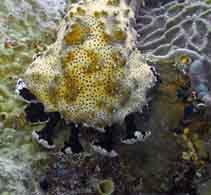Pearsonothuria graeffei (Semper, 1868)
Blackspotted sea cucumber| Native range | All suitable habitat | Point map | Year 2050 |

|
| This map was computer-generated and has not yet been reviewed. |
| Pearsonothuria graeffei AquaMaps Data sources: GBIF OBIS |
Classification / Names Common names | Synonyms | CoL | ITIS | WoRMS
Holothuroidea | Holothuriida | Holothuriidae
Environment: milieu / climate zone / depth range / distribution range Ecology
Reef-associated; depth range 0 - 30 m (Ref. 122). Tropical
Distribution Countries | FAO areas | Ecosystems | Occurrences | Introductions
Indo-Pacific, excluding the Persian Gulf and Hawaii.
Length at first maturity / Size / Weight / Age
Maturity: Lm ? range ? - ? cm Max length : 45.0 cm TL male/unsexed; (Ref. 122); common length : 35.0 cm TL male/unsexed; (Ref. 122); max. published weight: 1.3 kg (Ref. 122)
Short description Morphology
Mean live weight 700 to 1,300 g; body-wall thickness 0.4 cm. Body sub cylindrical, arched dorsally (bivium) and slightly flattened ventrally (trivium). White conical papillae sparsely distributed on bivium; podia on trivium long and large, their calcareous disc around 240 micrometer in diameter. Mouth ventral, surrounded by 25 large, black brown dots and numerous small black spots; trivium grey, also with small black spots. Spicules on dorsal and ventral tegument with pseudo-tables and rosettes; pseudo-tables consisting of large base with a large hole, and a spiny spire; rosettes numerous, those in the tegument simple, but more complicated in the dorsal papillae and ventral podia; also present around anus are rods, small plates, and tables with very spiny crown; tentacles containing a few rods and large plates derived from rosettes.
Maximum depth from Ref. 85218. Not harvested for bêche-de-mer production (Ref. 122). A coral reef species rarely found in depths of more than 25 m; mostly found on reef slopes close to the coast (Ref. 122, 85218); abundant on corals mixed with calcareous red algae. Population densities generally less than 0.005 per square meter (Ref. 122). In times of considerable irritation, this animal ejects Cuvierian tubules (Ref. 85218). Feeds on the surface of coral colonies and sponges (Ref. 101700).
Life cycle and mating behavior Maturity | Reproduction | Spawning | Eggs | Fecundity | Larvae
Members of the class Holothuroidea are gonochoric and have only one gonad. Spawning and fertilization are both external and some exhibit brooding. Life cycle: Embryos develop into planktotrophic larvae (auricularia) then into doliolaria (barrel-shaped stage) which later metamorphose into juvenile sea cucumbers.
Main reference
References | Coordinator | Collaborators
Conand, C. 1998. (Ref. 122)
IUCN Red List Status (Ref. 130435)
Least Concern (LC) ; Date assessed: 18 May 2010
CITES status (Ref. 108899)
Not Evaluated
CMS (Ref. 116361)
Not Evaluated
Threat to humans
Harmless
Human uses
Fisheries: of no interest
| FishSource |
Tools
More information
Internet sources
BHL | BOLD Systems | CISTI | DiscoverLife | FAO(Publication : search) | Fishipedia | GenBank (genome, nucleotide) | GloBI | Gomexsi | Google Books | Google Scholar | Google | PubMed | Tree of Life | Wikipedia (Go, Search) | Zoological Record
Estimates based on models
Preferred temperature
(Ref. 115969): 26.9 - 29.3, mean 28.6 (based on 2892 cells).
Price category
(Ref. 80766):
Unknown.



